A bench-top liquid handler with enough flexibility to automate numerous common applications is the OT-2.
OT-2 Liquid Handling Robot Features - Automated Pipetting
Video Credit: Opentrons
Automate the most time-consuming applications in the lab
General liquid handling
The easiest method for making time in the lab. The OT-2 pipetting robot makes it simple to automate various fundamental liquid handling operations, such as sample pooling, cherry picking, serial dilution, tube and microplate filling, and normalization. Users can design their own protocol, ask the Applications Engineering team to create one for them or select from various verified protocols in the Protocol Library.

Image Credit: Opentrons
PCR setup
Another common use for automation particularly when preparing a large number of samples. To mix samples and PCR mastermix in the reaction plate that will be placed in the thermocycler or qPCR machine, use the OT-2 pipetting robot.
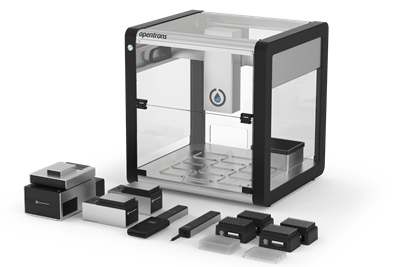
Image Credit: Opentrons
Protein purification
The most economical method for processing proteomics samples, enzymatic and chemical lysis, and small-scale protein purification on an automated basis. Two automation approaches are available for the OT-2 pipetting robot: dual-flow chromatography-based automation and magnetic bead-based automation.

Image Credit: Opentrons
Small footprint, big impact
Tech specs
Source: Opentrons
| |
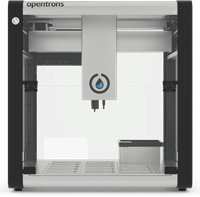 |
| Dimensions |
63 cm x 57 cm x 66 cm / 25 in x 22.5 in x 26 in (W,D,H)
Takes up half of your standard lab bench |
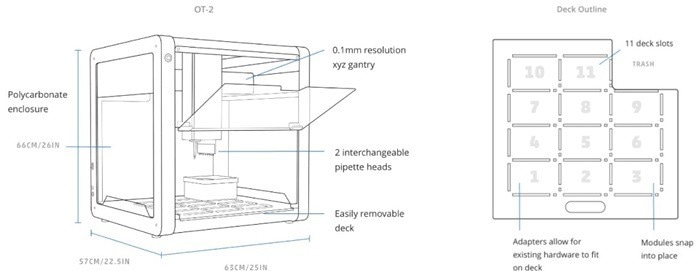 |
| Weight |
48 kg or 105.8 lb |
| Pipette configurations |
Single- and 8-channel pipetting
2 pipette mounts, for a configuration of 1 or 2 single- or 8-channel pipettes. Pipettes are easily interchangeable. |
| Pipette volumes and specs |
Single-channel: 1-1000 µL
8-channel: 1-300 µL |
| Deck |
11 deck slots enable countless configurations
Deck slots are compatible with standard SBS dimensions.
Deck also includes a removable trash bin. |
| Connectivity |
WiFi 2.4 GHz IEEE 802.11b/g/n, USB 2.0 |
| Video |
Integrated video camera (Included for future or custom functionality) |
| Audio |
Integrated audio system (Included for future or custom functionality) |
| Power requirements |
Robot Power Input: 36 VDC, 6.1 A
Power Adapter Input: 100-240 VAC, 50/60 Hz, 4.0 A/115 VAC, 2.0 A/230 VAC
For additional power requirement information, please review this support article |
| Frame composition |
Rigid steel and CNC aluminum design |
| Operating temperature & relative humidity |
Recommended 20-24 °C
Recommended 40-60% RH |
| Time to fill 96-well plate |
| Pipette |
Distribute,
one tip |
Transfer,
same tip |
Transfer,
new tip |
| P20 8-Channel |
0:22 |
1:35 |
4:19 |
| P300 8-Channel |
0:26 |
1:38 |
4:24 |
| P20 Single-Channel |
3:12 |
13:10 |
36:01 |
| P300 Single-Channel |
4:01 |
13:39 |
41:31 |
| P1000 |
5:54 |
15:21 |
44:50 |
|
| Single-channel accuracy & precision |
| Pipette |
Volume |
Random Error |
Systematic Error |
| |
|
%D |
µl |
%CV |
µl |
| P20 |
1
10
20 |
±15%
±2%
±1.5% |
0.15 µl
0.2 µl
0.3 µl |
±5%
±1%
±0.8% |
|
| P300 |
20
150
300 |
±4%
±1%
±0.6% |
0.8 µl
1.5 µl
1.8 µl |
±2.5%
±0.4%
±0.3% |
|
| P1000 |
100
500
1000 |
±2%
±1%
±0.7% |
2.0 µl
5.0 µl
7. 0µl |
±1%
±0.2%
±0.15% |
|
|
| 8-channel accuracy & precision |
| Pipette |
Volume |
Random Error |
Systematic Error |
| |
|
%D |
µl |
%CV |
µl |
| P20 |
1
10
20 |
±20%
±3%
±2.2% |
0.2 µl
0.3 µl
0.44 µl |
±10%
±2%
±1.5% |
|
| P300 |
20
150
300 |
±10%
±2.5%
±1.5% |
2.0 µl
3.75 µl
4.5 µl |
±4%
±0.8%
±0.5% |
|
|
| Sterility |
Full polycarbonate enclosure designed to limit exposure. The OT-2 is not a sterile environment
Add the Opentrons HEPA Module, or add your own UV lights |
| Viscosity |
For best practices on automating viscous liquid handling, review our application note
Viscous Liquid Handling Automation using Opentrons OT-2 › |
| API compatibility |
Interfaces with any product that has an API
Opentrons software is open-source and users can make adjustments to the software as needed to interface with other products. While all integrations are possible, they all require custom code work i.e. most customers will need to write custom libraries and install software packages that are not shipped with the robot. |
| Interface |
Windows 10, macOS 10.10 or later, Ubuntu 12.04 or later.
Opentrons App |
| Tip compatibility |
Use Opentrons Tips and Opentrons Filter Tips
Opentrons guarantees the performance of Opentrons Tips which were specifically designed for the OT-2. The OT-2 was designed to accommodate all universal bore tip types, but tip quality and dimensions can vary significantly so third party tip performance cannot be guaranteed by Opentrons. |
| Labware compatibility |
Use common labware already in our Labware Library, or add your own. If your labware fits on the OT-2 but is not in the Labware Library, it can be added by you using our Labware Creator, or by our team. |
| Warranty |
One-year warranty against manufacturer defects
Stress tested to last a minimum of 3 years of full-time use |
| Return policy |
60 days, 100% risk-free |
| Certifications |
Certifications complete (CE, FCC, NRTL, CB, ISO 9001)
Not certified/validated (IVD, GMP) |
| Example Commands |
Tip Handling
Pick up tip
Drop tip
Return tip
New tip (always, never, once)
More…
Liquid Control
Aspirate
Dispense
Aspirate speed
Dispense speed
Blowout
Touch tip
Mix
Air gap
Utility
Move to
Delay
User-specified pause
Homing
Comment
Transfer
Basic transfer
Volumes > Pipette Volume
Distribute
Consolidate
Variable Settings
Speed
Volume
Count
Other
Dispose |
| What’s in the box |
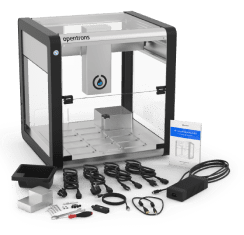
OT-2 robot
Calibration block
Removable block
Trash container
Quickstart guide
Power supply and regional IEC cable
Ethernet cable
Ethernet-to-USB dongle
Tool kit |
Use what is provided, add what is needed

Image Credit: Opentrons
Source: Opentrons
| Choose your hardware and pipettes |
Use your existing labware and reagents |
| 11 deck slots, plus trash, and space for two swappable, single and 8-Channel pipettes |
Magnetic, Temp, Thermocycler, Heater-Shaker, and HEPA Filter modules available |
| Reagent and consumables agnostic |
Compatible with any ANSI/SLAS-compliant labware |
Choose the protocol method that is right for the user
The code that directs the robot through the experiment is called a protocol. The company has developed several methods for developing a protocol that anyone can use, regardless of experience level with Python coding or automation.
Custom Protocol
Ideal for users desiring a fast, unique, or complex protocol. Has a protocol designed specifically for experiments by experts.
Protocol library
Ideal for novices wishing to acquire experience. Examine open-source, well-documented protocols.
Protocol designer
Ideal for people who wish to develop a new protocol without knowing how to code. Create new protocols with a user-friendly drag-and-drop interface.
Python protocol API
Ideal for users who have knowledge of Python. They can use the open-source Python Protocol API to create their own protocol.
Space for two pipettes
Dependable liquid transfers between 1 and 1000 µL using interchangeable single- and 8-channel pipettes

Image Credit: Opentrons
SINGLE-CHANNEL

Image Credit: Opentrons
8-CHANNEL
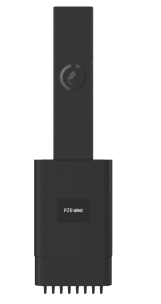
Image Credit: Opentrons